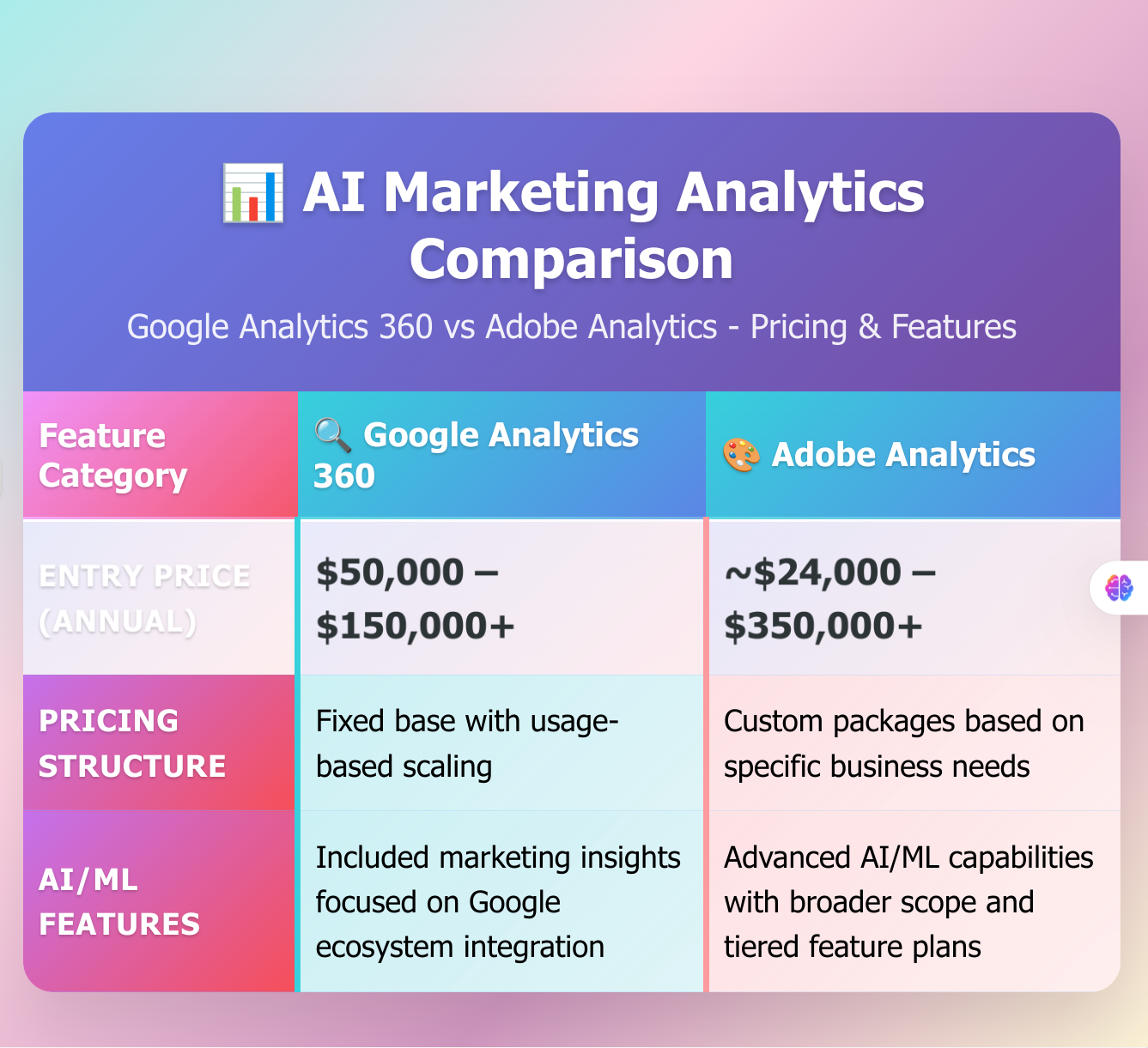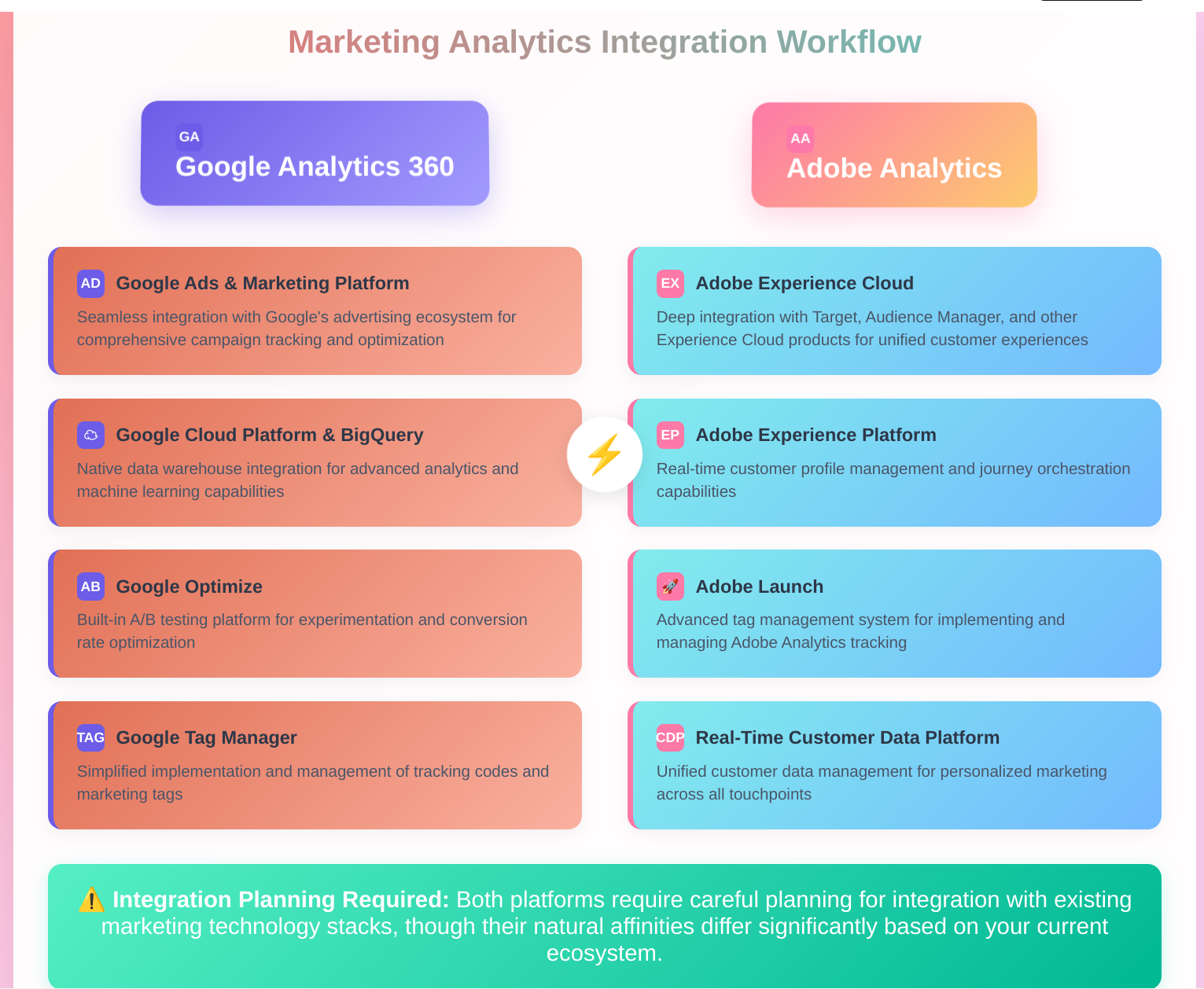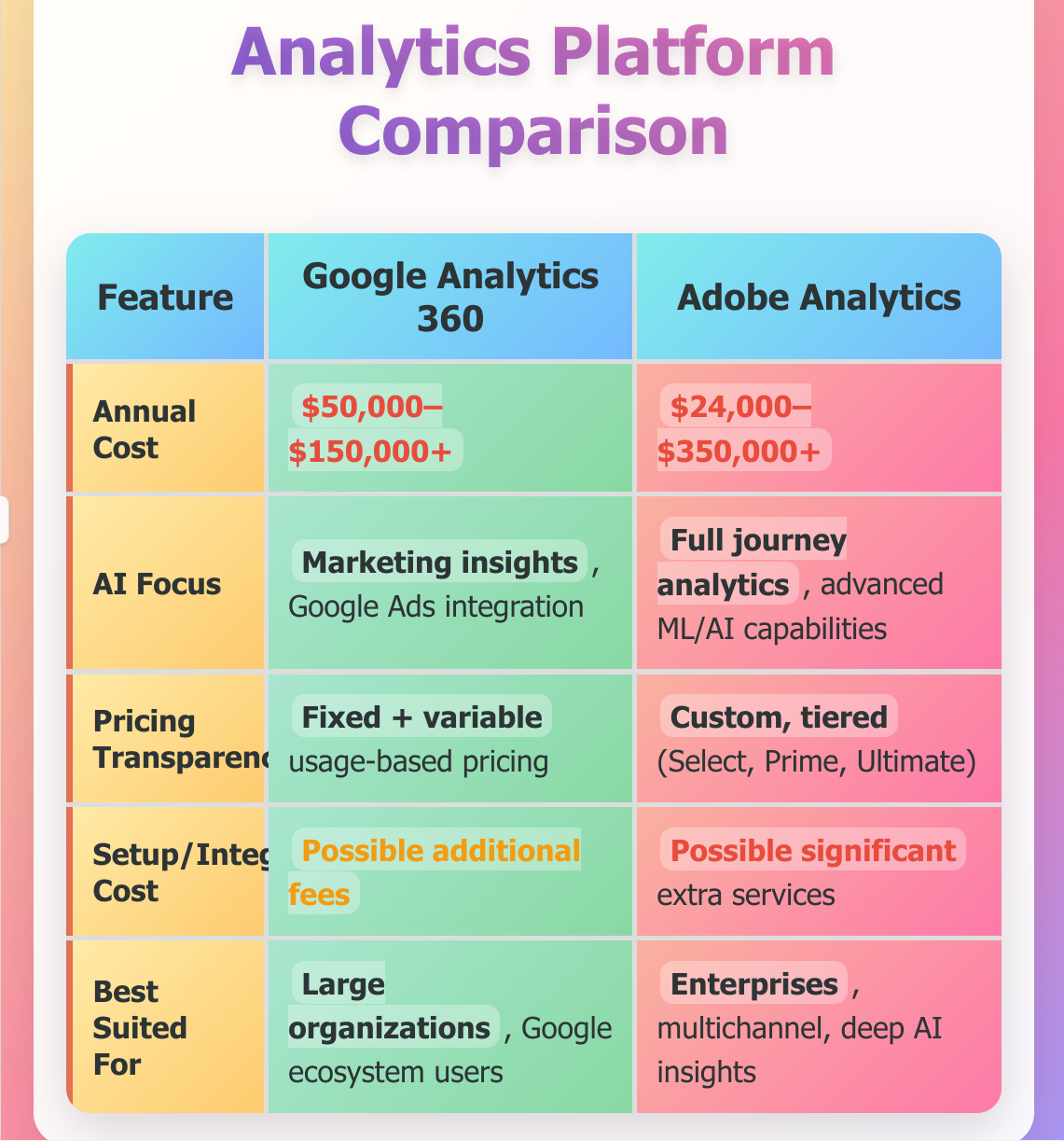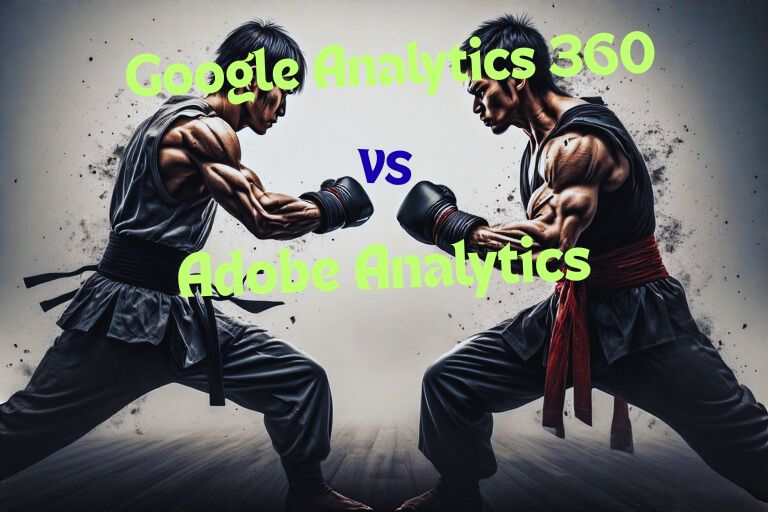Compare Google Analytics 360 ($50,000+/year) with Adobe Analytics ($24,000+/year) for AI marketing capabilities. GA360 excels in predictive analytics within the Google ecosystem, while Adobe Sensei offers advanced cross-channel attribution. Neither provides native pricing tools, but both platforms create the foundation for AI-driven pricing strategies.
Find out more about business analytics data here: https://amzoraltd.com/predictive-vs-descriptive-ai-marketing-analytics-for-roi/
- Google Analytics 360 pricing starts at $50,000/year while Adobe Analytics begins around $24,000/year, with both platforms scaling to $150,000+ and $350,000+ respectively based on data volume and features.
- Adobe Analytics uses Adobe Sensei AI for advanced cross-channel attribution and anomaly detection, while GA360’s AI capabilities focus on predictive analytics within the Google ecosystem.
- Content Marketing Agent helps businesses navigate these complex analytics platforms to maximize their AI marketing potential and ROI.
- Neither platform offers native dynamic pricing tools, but both provide the data foundation necessary for implementing AI-driven pricing strategies.
- Your existing technology stack and specific AI marketing priorities should be the primary factors when choosing between these enterprise analytics solutions.
Choosing between Google Analytics 360 and Adobe Analytics for AI-powered marketing insights isn’t just about picking a tool—it’s about making a strategic investment that aligns with your business goals and ecosystem. As data analytics experts at Content Marketing Agent regularly observe, each platform offers distinct advantages for enterprise pricing intelligence.
The Pricing Reality
of Both Platforms

1. GA360: $50,000-$150,000+ with predictable scaling
Google Analytics 360 employs a relatively straightforward pricing model that starts at approximately $50,000 annually. This base fee typically covers up to 25 million events per month, making it suitable for large organizations with substantial traffic. As your data needs grow, so does the price—scaling beyond the initial threshold can push costs well over $150,000 per year for high-volume implementations.
What makes GA360’s pricing structure distinct is its predictability. The platform uses a fixed base fee with clear usage-based increases, allowing for more straightforward budgeting. This transparency can be particularly valuable for organizations that need to plan their analytics expenditure with precision.
2. Adobe Analytics: $24,000-$350,000+ with custom quotes
Adobe Analytics takes a different approach to pricing, starting at around $24,000 annually for entry-level implementations. However, for enterprise-scale deployments with advanced AI features, costs commonly exceed $350,000 per year. The platform operates on a custom pricing model that scales based on specific business requirements.
Unlike GA360, Adobe doesn’t publish standardized pricing. Instead, they offer three primary tiers—Select, Prime, and Ultimate—each providing progressively more advanced capabilities. This tiered approach allows businesses to match their investment to their analytics maturity and data complexity needs.
3. Hidden costs that marketing budgets often miss
Beyond the core subscription fees, both platforms involve additional costs that are frequently overlooked in initial budgeting:
- Implementation and configuration: Professional services for proper setup can range from thousands to tens of thousands of dollars
- Training and enablement: Ensuring your team can effectively use these sophisticated tools requires investment
- Data integration: Connecting these platforms with other business systems often incurs additional costs
- Custom development: Building specialized reports or dashboards typically requires developer resources
- Data storage: Long-term retention of historical data may require additional investment, especially for high-volume implementations
AI Marketing Capabilities That Drive ROI
While pricing considerations are important, the real value of these platforms lies in their AI-powered features that can transform your marketing strategy and drive measurable business results.
GA360’s AI strengths in the Google ecosystem
Google Analytics 360’s artificial intelligence capabilities are tightly integrated with the broader Google ecosystem, creating a powerful closed-loop system for marketing optimization. The platform uses Google’s sophisticated machine learning algorithms to deliver predictive insights that can significantly enhance marketing performance.
Key AI capabilities in GA360 include:
- Predictive audience building: Automatically identifies users who are likely to convert or churn based on their behavior patterns
- Smart attribution modeling: Uses machine learning to understand the true impact of each marketing touchpoint
- Automated insights: Surfaces statistically significant patterns and anomalies without manual analysis
- Enhanced data activation: Seamlessly pushes AI-derived segments to Google Ads and other marketing platforms for automated optimization
These capabilities are particularly valuable for organizations heavily invested in Google’s advertising platforms. The tight integration between analytics and ad tools creates a seamless flow of intelligence that can dramatically improve campaign performance and ROI.
Adobe Sensei’s advanced cross-channel intelligence
Adobe Analytics takes a different approach to AI, using Adobe Sensei—the company’s advanced artificial intelligence and machine learning framework. Sensei powers a range of sophisticated features designed to extract deeper insights from complex customer journeys across multiple channels.
Adobe’s AI strengths include:
- Anomaly detection: Automatically identifies statistically significant deviations from expected patterns
- Algorithmic attribution: Uses advanced modeling to determine the true contribution of each marketing touchpoint
- Segment IQ: Automatically compares segments to uncover statistically significant differences
- Predictive analytics: Forecasts future customer behaviors and business outcomes
- Cross-channel analysis: Provides unified intelligence across web, mobile, offline, and other digital touchpoints
Adobe’s AI capabilities are particularly powerful for enterprises with complex, multi-channel customer journeys that extend beyond the digital realm. The platform excels at connecting disparate data sources to create a unified view of the customer experience.
How both platforms support pricing optimization (indirectly)
It’s worth noting that neither Google Analytics 360 nor Adobe Analytics offers native, explicit “dynamic pricing” or “price elasticity modeling” as direct, out-of-the-box features. However, both platforms provide the foundational data, advanced analytical capabilities, and AI-driven insights that are crucial inputs for pricing optimization strategies.
Google Analytics 360 supports pricing optimization through:
- Identifying high-value customer segments that might tolerate premium pricing
- Tracking conversion rates across different price points during promotions
- Measuring the revenue impact of various pricing strategies
- Exporting raw, unsampled data to BigQuery for custom price elasticity modeling
Adobe Analytics contributes to pricing intelligence via:
- Anomaly detection that can identify unexpected shifts in conversion rates following price changes
- Advanced segmentation to understand how different customer groups respond to pricing
- Cross-channel attribution to assess how pricing affects the customer journey
- Predictive modeling to forecast the potential impact of price adjustments
Implementation
Reality Check
Beyond features and pricing, successful deployment of these enterprise analytics platforms requires careful consideration of practical implementation factors.
Technical requirements and team expertise needed
Implementing either Google Analytics 360 or Adobe Analytics at an enterprise scale requires significant technical expertise and resources. Both platforms demand a sophisticated understanding of data architecture, tagging strategies, and integration methodologies.
For Google Analytics 360:
- Expertise in Google Tag Manager is typically essential
- Knowledge of data schema design for BigQuery exports
- Familiarity with Google Cloud Platform for advanced applications
- JavaScript skills for custom implementation
For Adobe Analytics:
- Experience with Adobe Launch or DTM for tag management
- Understanding of Adobe’s unique data collection methodology
- Knowledge of implementation variables (props, eVars, events)
- Expertise in Adobe Experience Platform for advanced integrations
Many organizations find they need to either train internal resources extensively or engage specialized implementation partners to successfully deploy these platforms. The learning curve for Adobe Analytics is generally considered steeper, but both platforms require significant expertise for enterprise-grade implementations.
Integration complexity with existing marketing stacks

Both platforms require careful planning for integration with your existing marketing technology stack, though their natural affinities differ significantly.
GA360 integrates most seamlessly with:
- Google Ads and the Google Marketing Platform
- Google Cloud Platform and BigQuery
- Google Optimize for A/B testing
- Google Tag Manager for implementation
Adobe Analytics connects naturally with:
- Adobe Experience Cloud products (Target, Audience Manager, etc.)
- Adobe Experience Platform
- Adobe Launch for implementation
- Adobe Real-Time Customer Data Platform
The integration effort and complexity largely depend on your current technology ecosystem. Organizations heavily invested in Google’s advertising and cloud offerings will find GA360 integrations more straightforward, while those using Adobe’s marketing suite will experience smoother implementation with Adobe Analytics.
Timeline from purchase to actionable insights
Implementing enterprise analytics is not an overnight process. Here’s what to expect regarding implementation timelines:
Google Analytics 360 typical timeline:
- Basic implementation: 4-8 weeks
- Advanced implementation with custom dimensions and BigQuery integration: 2-4 months
- Full maturity with AI-driven insights: 6-12 months
Adobe Analytics typical timeline:
- Basic implementation: 6-10 weeks
- Advanced implementation with custom frameworks: 3-6 months
- Full maturity with cross-channel insights: 8-14 months
These timelines can vary significantly based on your organization’s size, complexity, and resources dedicated to the implementation. Realistic expectations around time-to-value are crucial for planning and measuring success.
Documented
Business Impact
Both platforms have demonstrated significant ROI for enterprises that implement them effectively. Understanding the potential business impact helps justify the substantial investment these tools require.
1. Conversion rate improvements
GA360 and Adobe Analytics users consistently report meaningful increases in conversion rates after implementation:
- GA360 customers have documented conversion rate improvements of 15-50% through better audience targeting and journey optimization
- Adobe Analytics implementations have shown conversion lifts of 10-40% through advanced segmentation and cross-channel optimization
These improvements stem from the platforms’ ability to identify friction points in the customer journey, optimize based on user behavior patterns, and create more relevant, personalized experiences.
2. Revenue growth metrics
Beyond conversion improvements, both platforms contribute directly to revenue growth:
- GA360 users report revenue increases of 10-30% through optimized marketing spend and improved targeting
- Adobe Analytics customers have documented 15-25% revenue growth through enhanced customer journey optimization and personalization
The revenue impact typically comes from a combination of increased conversion rates, higher average order values, and improved customer retention—all enabled by the deep customer insights these platforms provide.
3. Marketing efficiency gains
Operational efficiency is another key area where these platforms deliver measurable ROI:
- GA360 implementations have reduced wasted ad spend by 20-40% through improved attribution and audience targeting
- Adobe Analytics users report 30-50% improvements in marketing resource allocation efficiency
By providing clear visibility into what’s working and what isn’t, these platforms help organizations eliminate ineffective marketing activities and double down on high-performing channels and tactics.
4. Customer journey optimization
Both platforms excel at helping businesses understand and optimize the entire customer journey:
- GA360 users have reduced abandonment rates by 15-35% by identifying and addressing key friction points
- Adobe Analytics implementations have improved customer retention by 10-30% through better understanding of the full customer lifecycle

5 Decision Factors for Choosing Your Platform
Selecting between these powerful platforms requires careful consideration of several key factors:
1. Current technology ecosystem alignment
This is often the most decisive factor. If your organization is heavily invested in:
- Google’s advertising platforms and cloud services, GA360 will provide more seamless integration and data flow
- Adobe Experience Cloud products, Adobe Analytics will offer a more unified approach to customer experience management
Swimming against your existing technology current can create unnecessary friction and reduce overall ROI.
2. Data volume and complexity requirements
Assess your organization’s specific data needs:
- For high-volume websites with relatively straightforward user journeys, GA360’s scalable processing capabilities may be sufficient
- For complex, multi-channel customer journeys with diverse data sources, Adobe Analytics’ flexible data collection and advanced segmentation might be more valuable
3. Available budget vs. expected ROI
Budget constraints are real, but should be considered in context of potential returns:
- If your budget is more limited, GA360’s more predictable pricing structure may be more appealing
- If you can justify a larger investment based on specific business outcomes, Adobe Analytics’ advanced capabilities might deliver higher overall ROI
4. Internal expertise and resources
Honestly assess your team’s capabilities and bandwidth:
- If you have limited dedicated analytics resources, GA360’s more intuitive interface and simpler implementation may be more realistic
- If you have experienced analysts and developers, Adobe Analytics’ powerful customization capabilities can be fully used
5. Specific AI marketing priorities
Identify your organization’s most critical AI-driven use cases:
- If your focus is on digital advertising optimization and predictive audience targeting, GA360’s tight integration with Google’s ad platforms may be ideal
- If you prioritize anomaly detection, cross-channel attribution, and complex customer journey analysis, Adobe Analytics’ more advanced AI capabilities could be more valuable
Make the Right Investment for Your AI Marketing Strategy
Choosing between Google Analytics 360 and Adobe Analytics isn’t about selecting the “better” platform—it’s about finding the right strategic fit for your organization’s specific needs, capabilities, and goals. Both platforms offer powerful AI capabilities that can transform your marketing effectiveness and drive significant business results when properly implemented and used.
Content Marketing Agent provides expert guidance to help businesses maximize their analytics investment and derive actionable AI-driven marketing insights from their data.


